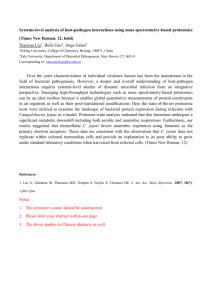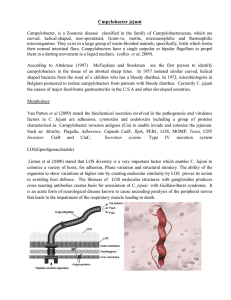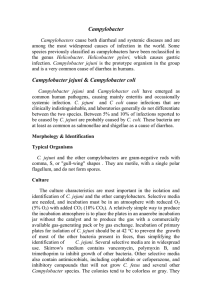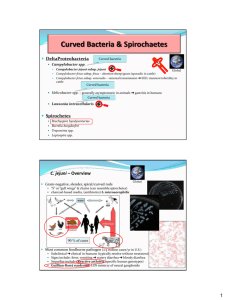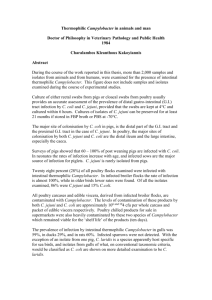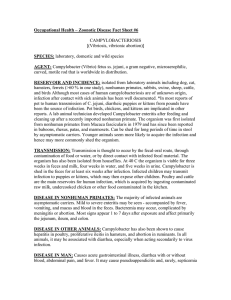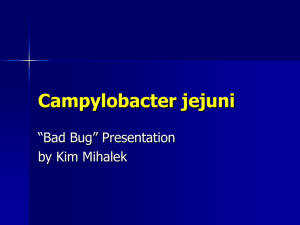Campylobacter jejuni Immunomagnetic separation methods
advertisement
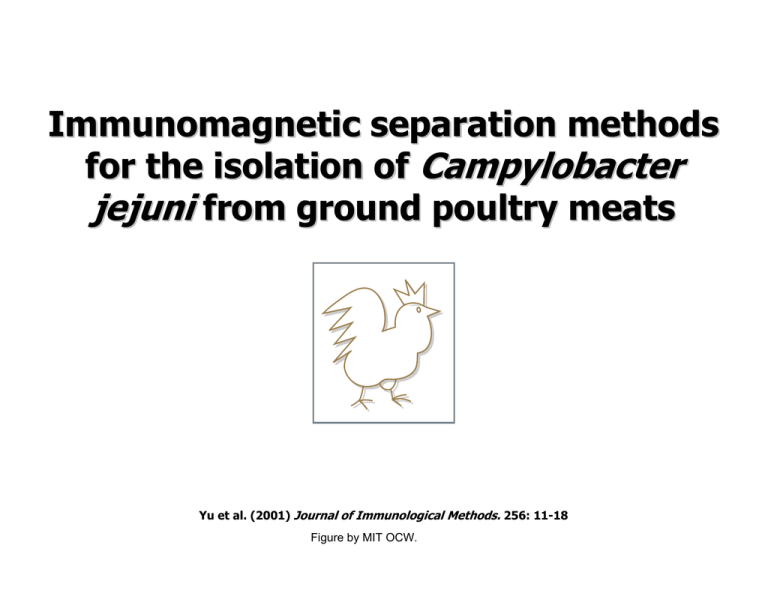
Immunomagnetic separation methods methods for the isolation of Campylobacter Campylobacter jejuni from ground poultry meats meats Yu et al. (2001) Journal of Immunological Methods. 256: 11-18 Figure by MIT OCW. Introduction Introduction Campylobacter jejuni : the most frequent identified cause of human gastroenteritis and campylobacteriosis Figure removed due to copyright reasons. Most commonly found in the intestinal tract of birds. 30-100 % of poultry carry C. jejuni in their intestinal tracts! Figure by MIT OCW. Introduction Introduction Traditional methods used to detect C. jejuni - require 4-5 days - involve selective enrichment followed by confirmation by biochemical and serological tests - must overcome the problems of inhibitors from food sources Due to the perishable nature of these foods, we need a more rapid, sensitive and specific method to monitor potential sources of pathogens!! We evaluated the performance of two types of Immuno-Magnetic Beads (IMBs) in capturing and concentrating C. jejuni directly from poultry meats Magnetic Beads Beads Figure removed to due copyright reasons. Please see: Yu, L. S., J. Uknalis, and S. I. Tu. "Immunomagnetic separation methods for the isolation of Campylobacter jejuni from ground poultry meats." J Immunol Methods 256, no. 1-2 (October 1, 2001): 11-8. Magnetic beads used to detect and separate C. jejuni from ground poultry AFM Imaging of IMBs IMBs We used Atomic Force Microscopy (AFM) to characterize the extreme discontinuities in the topography of the magnetic beads, and to emphasize the fine structural composition on different aspects of the surface. Reacting Surface: 3.4 x 10-3 m2 A knowledge of surface area from AFM data helps with better estimation of antibody volumes for coating! Figure removed to due copyright reasons. Please see: Yu, L. S., J. Uknalis, and S. I. Tu. "Immunomagnetic separation methods for the isolation of Campylobacter jejuni from ground poultry meats." J Immunol Methods 256, no. 1-2 (October 1, 2001): 11-8. Figure by MIT OCW. Detection of C. jejuni jejuni To ensure that our beads were capturing bacteria, we stained beadcaptured cells with DAPI and viewed them under a fluorescence microscope Tosylactivated beads have a higher fluorescence intensity/area than streptavidin beads. Figures removed to due copyright reasons. Please see: Yu, L. S., J. Uknalis, and S. I. Tu."Immunomagnetic separation methods for the isolation of Campylobacter jejuni from ground poultry meats." J Immunol Methods 256, no. 1-2 (October 1, 2001): 11-8. DAPI, or 4',6-Diamidino-2phenylindole, is a fluorescent probe that labels DNA! Figure by MIT OCW. Detection of C. jejuni jejuni C. jejuni 1) Inoculate poultry slurry with C. jejuni Figures by MIT OCW. 2) Incubate with IMBs 3) Plate beads and count Colony Forming Units (CFUs) The reactivity against Campylobacter cells with tosylactivated beads appeared to be slightly greater than with streptavidin beads! Sensitivity Limits: 104 cfu/g (ground poultry product) 103 cfu/g (pure culture sample) Conclusions Conclusions 1) Proof of concept: Immunomagnetic separation and agar plating effectively remove debris and concentrate C. jejuni from ground poultry meat! 2) Binding effectiveness: Tosylactivated beads appeared to have a higher binding efficiency to Campylobacter cells. * competition for binding sites between biotin and streptavidin beads may explain decrease in binding efficiency 3) Limitations of our technique: artificial inoculation of C. jejuni into ground poultry meat rather than naturally contaminated poultry meat * results may not be directly applied to practical situations 4) Alternate techniques under investigation: ELISA assay, bio- and chemiluminescence techniques * goal is to get shorter detection time and lower limits of detection
